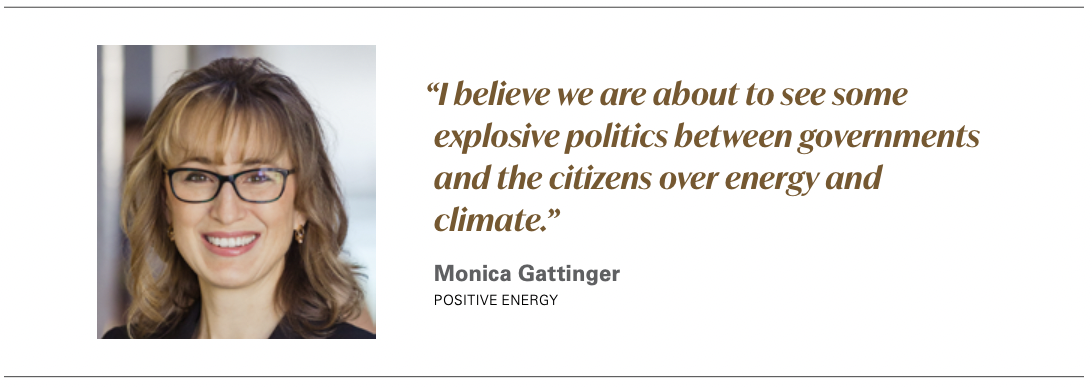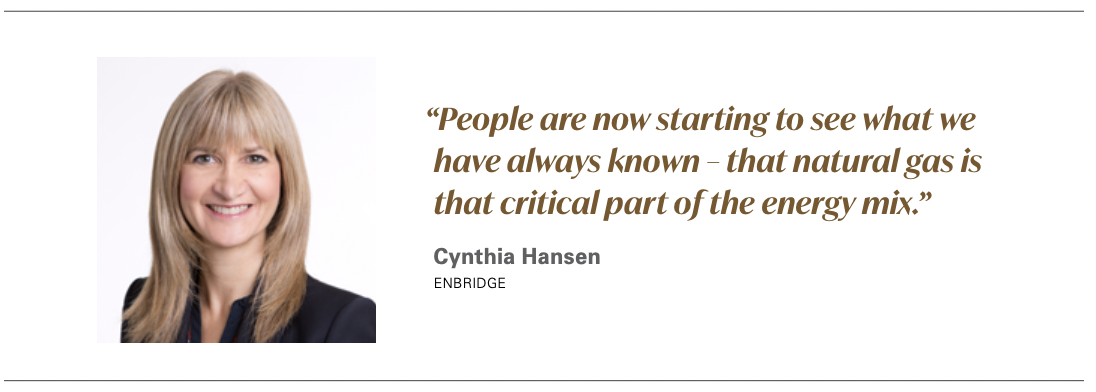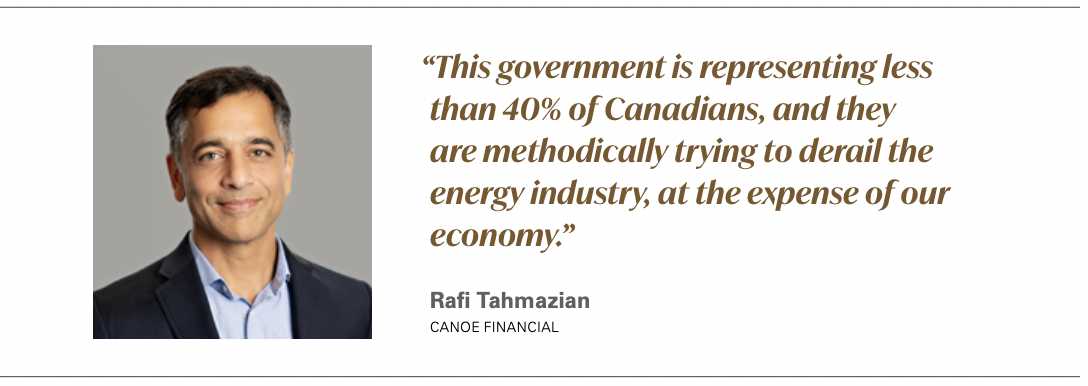Windy future for Canadian gas [Gas In Transition]
If there is any benefit to the energy crisis underway in Europe – and exacerbated by Russia’s invasion of Ukraine – it is that the world is finally waking up to the fact that natural gas is a critical component in the global energy mix.
It’s a fact that those in the natural gas industry have always known, but as a steady stream of panelists at Energy Nexus, a two-day conference hosted in Vancouver last month by the Canadian Gas Association (CGA), pointed out, it’s taken a combination of a cold winter, inadequate supplies of solar and wind energy, and rising demand for the message to begin to sink in.
|
Advertisement: The National Gas Company of Trinidad and Tobago Limited (NGC) NGC’s HSSE strategy is reflective and supportive of the organisational vision to become a leader in the global energy business. |
“People are now starting to see what we have always known – that natural gas is that critical part of the energy mix,” said Cynthia Hansen, at the time the chair of the Canadian Gas Association (CGA) and executive vice president at Enbridge. “It’s clean, it’s affordable, it’s reliable. As we see countries look to address their overall climate goals and energy security, we know that natural gas and LNG from North America is going to be a critical part of how we meet those goals.”
The events in Europe, noted energy economist and historian Peter Tertzakian said, have resulted in what he terms a “break-point” in the transition to a lower-carbon energy system. And with every break-point, there is an accompanying shock – in the case of the energy “transition”, that shock has materialised as regressive transition.

“We are still in the regressive stage of the transition,” he said. “But three or four months from now, we will go from the regressive in the immediate, we will get some policy actions, hopefully some demand drop and supply balancing so that the price can stabilise a little bit; that is when you get back to the progressive transition.”
It is at that stage – when the transition turns progressive again – that the natural gas industry can help influence the next stage of the transition and offer its own ideas and solutions. But, Tertzakian said, the conversation first needs to come down from the high-level, theoretical navel-gazing that has characterised Canada’s policy-making so far and reach the boardroom tables, where decision makers “are actually thinking about how they are going to do this stuff.”
Duelling agendas
When the conversation does eventually come down to earth, Marla Orenstein, director of the Natural Resource Centre at the Canada West Foundation and a frequent commentator on Canadian energy policy, questioned Ottawa’s approach to reducing emissions on a panel with a pair of federal bureaucrats.
On the one hand, prime minister Justin Trudeau is promising to aid Canada’s European allies with more energy – primarily natural gas – but on the other, his government is blocking critical infrastructure, including pipelines, needed to get that energy to markets.
“We have a domestic agenda and we have an international agenda when it comes to emissions reduction, and particularly when we are looking at natural gas, these two agendas are at odds with each other,” she said. “How does the federal government plan to have Canada export natural gas while we are missing our own emission reduction targets because we have drawn this artificial boundary around the jurisdiction, so we can’t have any more emissions so no more natural gas production?”
Glenn Hargrove, assistant deputy minister in the fuels sector at Natural Resources Canada, said Ottawa would square that particular circle “by looking at several pathways to decarbonise LNG, through electrification, through a long-term pathway to hydrogen. And we also have to determine how we can ensure that LNG exports from Canada are, in fact, displacing coal use.”
Most un-nerving for producers, however, is a looming cap on oil and gas production that Ottawa hopes will help it meet its net zero aspirations, including a 40% reduction by 2030, a goal set out by the government in its latest emissions reduction plan.
John Moffet, assistant deputy minister in the federal environment and climate change ministry’s environmental protection branch, confirmed that the cap will almost certainly apply to most oil and gas production emissions, and will take the form of some sort of regulatory requirement, whether through amending existing regulations or imposing new rules.
Heavy hand
And it’s that threat of new regulation – on top of a tsunami of new regulations that have hit the industry since Ottawa embarked on its net zero journey – that has fundamentally transformed how energy policy in Canada is developed.
In a keynote presentation, Monica Gattinger, director of the Institute for Science, Society and Policy at the University of Ottawa and founder and chair of its Positive Energy program, said policy-making and government intervention in Canada has moved from a hidden hand approach to a heavy hand approach.

“After some 40 years of relatively stable market-based energy systems we are entering a world of policy-based energy systems,” she said. “This time they’re providing environmental regulation that’s constraining and prohibiting across any and all energy markets. To me this is a seismic shift, and it’s a shift that is happening at an ever-accelerating pace and scale, with relatively limited debate and analysis informing government choices.”
Governments – not just at the federal level but in some cases at the provincial level – have prescribed high expectations of the industry, which is expected to do most of the heavy lifting to get to net zero, she said.
“They expect industry to innovate, to reduce emissions, to develop new business models, to invest, to plan and build projects, and all of this at an absolutely eye-popping pace and scale.”
Canadians, meanwhile, are being asked to control costs, change their lifestyles, retrain to earn jobs outside the energy industry and agree to massive new infrastructure in their communities, all in the service of net zero. Eventually, those expectations are going to create a backlash, Gattinger warned.
“I believe we are about to see some explosive politics between governments and the citizens over energy and climate,” she said. “To date, debates over energy and climate in Canada have been limited mostly to oil and gas and have tended to take place between energy and environmental or climate experts in government, in energy, in ENGOs.”
Going forward, the debate will shift to one surrounding the actual social and economic realities of transforming Canada’s energy sector, she said. “The public is waking up to the true costs to them directly of addressing climate change.”
The City of Toronto – Canada’s most populous – has doubled down on its own net zero commitments, with a promise to get there by 2040. Most of the heavy lifting to meet that earlier goal, Gattinger said, will come from increased electrification, but the cost of building out the city’s power grid to meet that added demand has been estimated at some C$10bn.
That is expected to increase residential power rates in Toronto by 19% each year between 2025 and 2029, and by 5-6%/year after that. “Not surprisingly, there has been sticker shock over this in Toronto.”
Social contract
So far, Gattinger said, Ottawa’s heavy-handed approach to setting policies to reach net zero has been one way: industry has been handed a set of expectations, citizens have been told what they will have to do. What’s missing, she said, is what she calls a “social contract” for energy, an agreement between governments and those who are governed, over their respective rights and responsibilities.
Ottawa should be developing coherent, clear and certain energy and environmental policy which provides for an energy system approach to decision making, recognising the complexity and interconnectedness of energy systems and moving away from the idea that there is a silver bullet that will solve the climate crisis.
Reducing emissions needs to be approached with an eye on both the energy and economic imperatives, she said, notably energy security, which includes affordability and reliability.
Governments at all levels need to collaborate, paying attention to differences at federal, provincial, municipal and indigenous levels, and decision-making needs to be clear, timely, inclusive and predictable.

“When I look at any of the work that needs to be done around emissions reductions, it all hinges on being able to build, permit and finance a mind-boggling amount of energy infrastructure,” she said. “Do we have the systems that are going to foster investor confidence to do that?”
Depolarise to decarbonise
Until now, little of this two-way policy debate has emerged, and it has led to a deep polarisation between energy and environment, Gattinger said. She hopes that this polarisation will lessen as people become more aware of the true costs of decarbonisation, whether on the production side or the consumption side, but industry can begin to shift the narrative – move more to Tertzakian’s “progressive transition” by delivering its own coherent messaging.
“I’m optimistic that if industry were to come together and say ‘we need greater recognition from government that these are the sorts of things that we need to deliver on the high expectations that you have of us’ then collectively there could be greater recognition of policy needs,” she said. “If we don’t move in that direction, then I despair.”
Standing in the way of industry coming together and working collaboratively with government, however, is a key political reality in Canada – the federal government’s power base is focused in the central Canadian provinces of Ontario and Quebec, and in BC’s Lower Mainland. Collectively, those regions account for less than half of the Canadian population, and in the 2021 federal election, Trudeau’s Liberal Party collected a mere 33% of the popular vote.
“How can we work with policy-makers when those policy-makers represent less than 40% of the country, and they have an agenda that biases that policy,” wondered Rafi Tahmazian, director and senior portfolio manager at Canoe Financial. “Today I want everyone to come away talking about pragmatic thinking – that’s what we need, to start talking about this in a pragmatic, realistic fashion. Stop living in the dream world. Start talking with facts.”
The idea that Canada will begin reducing its use of hydrocarbons – and achieving meaningful emissions reductions – by 2030 is “violently” untrue, he said, pointing to the failed decarbonisation efforts in Germany which reduced dependence on fossil fuels by only 10 percentage points between 2000 and this year.
Nor can growing environmental, social and governance (ESG) investments be counted on to solve the climate issue. In the last three years, Tahmazian said, new ESG investments within the S&P Index have amounted to more than $1.5 trillion, against new non-ESG investments of about $500bn.
That huge investment, he said, went into very few ideas, into risky experiments, and while those companies with ESG investors “pocketed a bunch of cash, they all came back without any good results.”
What Canada really needs to advance the energy transformation is a new government, one that listens to those in the middle of the energy and climate debate, that recognises the realities, both economic and environmental, associated with the fight against climate change.
“This government is representing less than 40% of Canadians, and they are methodically trying to derail the energy industry, at the expense of our economy,” he said. “That’s not right, and we have to take it back so we can do what we do.”




